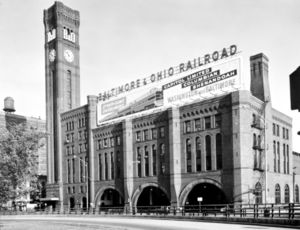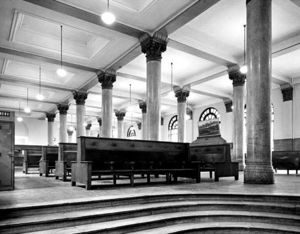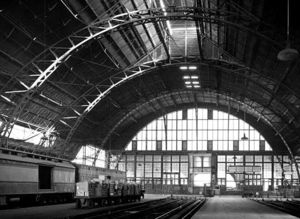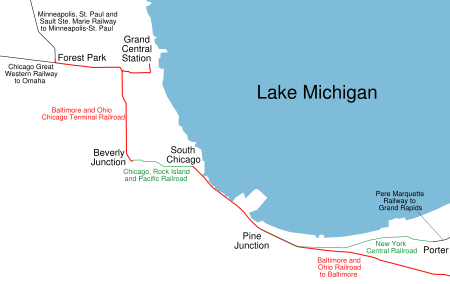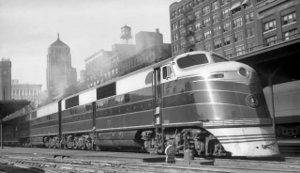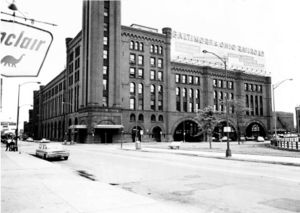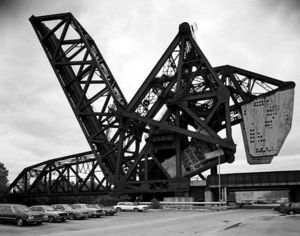Grand Central Station (Chicago)
2007 Schools Wikipedia Selection. Related subjects: Architecture; Railway transport
Grand Central Station was a passenger railroad terminal in downtown Chicago, Illinois from 1890 to 1969. It was located at 201 West Harrison Street in the south-western part of the Chicago Loop, the block bounded by between West Harrison Street, South Wells Street, West Polk Street and the Chicago River. Grand Central Station was designed by architect Solon Spencer Beman for the Wisconsin Central Railway, and was completed by the Chicago and Northern Pacific Railroad.
The station was built with the intention of its eventually becoming the eastern terminus for the transcontinental Northern Pacific Railway which was leasing the Wisconsin Central at the time of construction, and seeking access to the railway hub of Chicago. However, the Northern Pacific bankruptcy of 1893 ended the plan.
Grand Central Station was eventually purchased by the Baltimore and Ohio Railroad, which used the station as the Chicago terminus for its passenger rail service, including its glamorous Capitol Limited to Washington, D.C.. Major tenant railroads included the Soo Line Railroad, successor to the Wisconsin Central, the Chicago Great Western Railway, and the Pere Marquette Railroad. The station was eventually shuttered in 1969 and torn down in 1971.
Construction
In October 1889, a subsidiary of the Wisconsin Central Railroad (WC) began constructing a new passenger terminal at the southwest corner of Harrison Street and Wells Street (then called Fifth Avenue) in Chicago, to replace a temporary facility built nearby. The location of this new depot, along the south branch of the Chicago River, was selected to take advantage of the bustling passenger and freight market travelling on nearby Lake Michigan.
The station was executed in the Norman Castellated architectural style by architect Solon S. Beman, who had gained notoriety as the designer of the Pullman company neighbourhood. Constructed of brick, brownstone and granite, it was 228 feet (70 meters) wide on the side facing Harrison Street and 482 feet (147 meters) long on the side facing Wells. Imposing arches, crenellations, a spacious arched carriage-court facing Harrison Street, and a multitude of towers dominated the walls, but its most famous feature was an impressive 247 foot (75 meter) tower at the northeast corner of the property. Early on, an 11,000 pound (4,990 kilogram) bell in the tower rang in the hours. At some point, however, the bell was removed, but the tower (and its huge clock, 13 feet (4 meters) in diameter — at one time among the largest in the United States) remained.
The interior of the Grand Central Station was decorated as impressively as the exterior. The waiting room, for example, had marble floors, Corinthian-style columns, stained-glass windows and a marble fireplace. The station also had a restaurant and a hotel, but accommodations ended late in 1901.
The glass and steel train shed, 555 feet (169 meters) long, 156 feet (48 meters) wide and 78 feet (24 meters) tall, was the second largest in the world at the time it was constructed, and self-supporting. Grand Central housed six tracks and had platforms long enough to accommodate fifteen-car passenger trains; it was considered an architectural gem and a marvel of engineering when it was built.
The structure was formally opened on December 8, 1890 by the Chicago and Northern Pacific Railroad, a subsidiary of the Northern Pacific Railway which had purchased the terminal and the trackage leading up to it from the Wisconsin Central; it had cost one million dollars to construct. When it opened, Grand Central hosted trains from the WC (which connected with its former trackage in Forest Park, Illinois), and the Minnesota and Northwestern Railroad (M&NW), which made also a connection at Forest Park. By December 1891, the tenants also included the Baltimore and Ohio Railroad. In 1903, the Pere Marquette Railway also started using the station.
The B&O purchased Grand Central (and the all the terminal trackage) at foreclosure in 1910 to form the Baltimore and Ohio Chicago Terminal Railroad.
Services
The smallest of Chicago's passenger rail terminals, Grand Central Station was a relatively quiet place, even during its heyday. Grand Central never became a prominent destination for large numbers of cross-country travellers, nor for the daily waves of commuters from the suburbs, that other Chicago terminals were. In 1912, for example, Grand Central served 3,175 passengers per day — representing only 4.5 percent of the total number for the city of Chicago — and serviced an average of 38 trains per day (including 4 B&O suburban trains). This number paled in comparison to the 146 trains served by Dearborn Station, the 191 by LaSalle Street Station, the 281 at Union Station, the 310 by the Chicago and North Western Terminal and the 373 trains per day at Central Station.
The station hosted some of Baltimore and Ohio's most glamorous trains, including the fabulous Capitol Limited to Washington, DC. Unfortunately, however, the circuitous trackage leading up to the station from the east led these trains miles out of their way through the industrial southwest and west side of the city (See map to the left). As for the other tenants, the Soo Line Railroad (which purchased the WC in 1909), the M&NW (which became known as the Chicago Great Western Railway in 1893), and the Pere Marquette Railway (which was merged into the Chesapeake and Ohio Railway in 1947), none were particularly serious players in the intercity passenger rail market.
Intercity Passenger Trains
Grand Central Station served as a terminal for the following lines and intercity trains:
- Baltimore and Ohio Railroad - Capitol Limited to Washington, DC, Columbian to Jersey City, New Jersey, Shenandoah to New York City. Other trains to Cumberland, Maryland and Wheeling, West Virginia.
- Chicago Great Western Railway (until 1956) - Legionnaire, later Minnesotan, both to Minneapolis, Minnesota. Other trains to Kansas City, Missouri and Omaha, Nebraska.
- Minneapolis, St. Paul and Sault Ste. Marie Railway (Soo Line) (until 1899, and from 1912 to 1965; used Central Station in between and after) - Laker to Duluth, Minnesota.
- Pere Marquette Railway - Grand Rapids Flyer and Grand Rapids Express to Grand Rapids, Muskegon, Michigan, and ultimately Buffalo, New York. Upon the 1947 merger with the Chesapeake and Ohio Railway, PM trains were renamed Pere Marquette.
- From December 1900 to July 1903, the Lake Shore and Michigan Southern Railway ( New York Central Railroad) and Chicago, Rock Island and Pacific Railway used Grand Central, as their LaSalle Street Station was being rebuilt.
Suburban Commuter Trains
In addition to intercity passenger rail service, Grand Central Station also served as a terminal for a short-lived suburban commuter line first operated by the Chicago Terminal Transfer Railroad in 1900. The service, which was continued when the line was purchased by the B&O in 1910, ran six trains a day between Grand Central and Chicago Heights, stopping in Blue Island, Harvey, Thornton and Glenwood. The line was unsuccessful and ended as early as 1915. None of the other tenant railroads operated commuter trains out of Grand Central Station.
The End
The lightly-used terminal became ominously quiet through the 1950s and '60s. Trains were dropped, service trimmed back, and by 1956, one railroad, the Chicago Great Western, had stopped operating passenger service into Chicago altogether. Whereas immediately after the Second World War, Grand Central had served 26 intercity passenger trains — down from nearly 40 at its busiest — by 1963, only ten intercity trains — of which six were operated by the Baltimore and Ohio — remained. The number of passengers that used the remaining service also shriveled: by 1969, the year the station closed, the station only served an average of 210 passengers per day.
Declining intercity passenger rail traffic nationwide and corporate consolidation within the railway industry both created excess terminal capacity in Chicago. However, it was a political effort within the city to close Grand Central — described by the Chicago Tribune as "decaying, dreary, and sadly out of date," — that ultimately sealed the fate of the station. The Soo Line re-routed its trains into Central Station in 1965. The remaining six B&O and ex-Pere Marquette trains last used station on November 8, 1969 and were routed into their new terminus at the Chicago and North Western Terminal the following day.
Sitting unused with acres of abandoned terminal trackage to its south, Grand Central Station's value as an architectural and engineering masterpiece was discounted by its railroad owner, which believed the value of the land for urban redevelopment to be very substantial. As a result, all the trackage was scrapped, and the entirety of the terminal was razed by the railroad in 1971.
Present-day
Redevelopment of the property, however, has been slow. A 17-story apartment building known as River City was constructed in 1986 on the former coach yard and approaches to the terminal, but, ironically, the lot on which the station itself stood, still mostly owned by CSX Transportation (the successor company to the B&O), continues to be vacant. River City was designed to continue south to Roosevelt Road and at an earlier point meant to be a complex of three 68-story office and residential towers. Plans for an office tower, condominiums, or retail development on the Grand Central Station terminal site have all been proposed over the past several years, and all have been shelved. The site is currently a de facto dog park used by local residents, although outlines of platforms and building foundations hint at the lot's former use.
The B&OCT Bascule Bridge
At the time Grand Central was completed, passenger trains approached the terminal by crossing the Chicago River to the southwest over a bridge between Taylor Street and Roosevelt Road, constructed in 1885. This first bridge was replaced by a taller structure in 1901 to accommodate larger boats and ships on the south branch of the river. When the Chicago River was straightened and widened in the 1930s, the War Department insisted the B&O build a new bridge adjacent to that of the St. Charles Air Line Railroad which crossed the river between Fifteen and Sixteen Streets. The new bridge's location, about seven blocks south of their previous crossing, exacerbated the circuitous route of the B&OCT trackage leading to Grand Central Station. Both the B&O bridge, and of the St. Charles Air Line immediately adjacent to it, were built in 1930, and both are bascule bridges.
The B&OCT bridge, like the terminal and the tracks, has been abandoned. It was not dismantled and remains permanently locked in an "open" position. Because they are bascule bridges, both the B&OCT and the Air Line bridges each have a counterweight of their own, and in this case they share a common third counterweight between them. This design allowed them to operate in unison, with an operator from the B&OCT in charge of both bridges. This has led to a curious historical oddity, as the CSX, successor railroad to the B&O, owns a useless bridge that it cannot abandon, because it is needed to continue operating a bridge it does not own. An uncertain but inevitable future awaits the old B&OCT bridge, as the trackage it once served will likely never be rebuilt.
